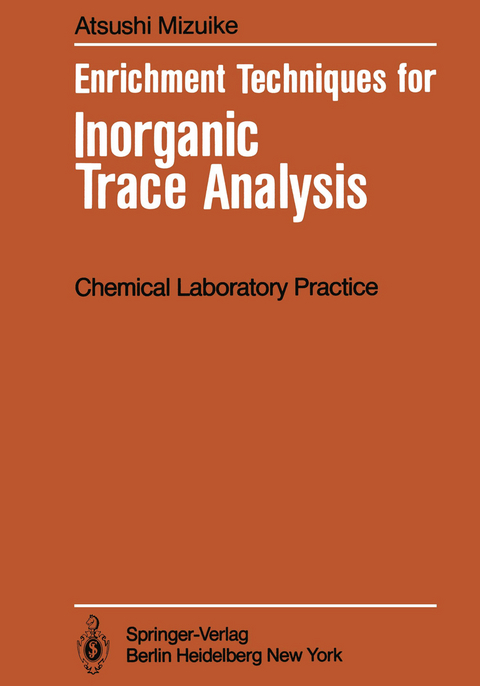
Enrichment Techniques for Inorganic Trace Analysis
Springer Berlin (Verlag)
978-3-642-68856-0 (ISBN)
1 Introduction.- 1.1 Inorganic Trace Analysis in Science and Technology.- 1.2 The Role of Enrichment Techniques in Inorganic Trace Analysis.- 2 General Aspects of Enrichment Techniques.- 2.1 Trace Recovery.- 2.2 Enrichment Factor.- 2.3 Contamination.- 2.4 Simplicity and Rapidity.- 2.5 Sample Size.- 3 Control of Contamination and Loss.- 3.1 Airborne Contamination.- 3.2 Contamination and Loss Due to Apparatus.- 3.3 Contamination Due to Reagents.- 3.4 Other Sources of Contamination and Loss.- 4 Volatilization.- 4.1 Volatilization from Solutions.- 4.2 Volatilization from Solid and Molten States.- 5 Liquid-Liquid Extraction.- 5.1 General Procedures.- 5.2 Extraction of Metal Chelates.- 5.3 Extraction of Ion Pairs.- 5.4 Special Extractions.- 6 Selective Dissolution.- 6.1 Selective Dissolution of the Matrix.- 6.2 Selective Dissolution of Trace Elements.- 7 Precipitation.- 7.1 Precipitation of Matrix Elements.- 7.2 Precipitation of Trace Elements.- 8 Electrochemical Deposition and Dissolution.- 8.1 Electrodeposition on Solid Electrodes.- 8.2 Electrodeposition on Mercury Cathodes.- 8.3 Spontaneous Electrochemical Deposition.- 8.4 Anodic Dissolution.- 9 Sorption, Ion Exchange and Liquid Chromatography.- 9.1 General Procedures.- 9.2 Separation with Ion Exchange Resins.- 9.3 Separation with Cellulosic Exchangers.- 9.4 Separation with Polyurethane Foams.- 9.5 Separation with Miscellaneous Organic Sorbents.- 9.6 Separation with Activated Carbon.- 9.7 Inorganic Ion Exchangers.- 10 Flotation.- 10.1 General Procedures.- 10.2 Carrier Precipitation Followed by Flotation.- 10.3 Ion Flotation.- 11 Freezing and Zone Melting.- 11.1 Freeze Concentration of Dilute Aqueous Solutions.- 11.2 Enrichment of Impurities in Solids by Zone Melting.- 12 Enrichment Techniques in Water Analysis.- 12.1 Separation Based on the Particle Size and Density.- 12.2 Separation Based on Chemical Reactivity.- 13 Enrichment Techniques in Gas Analysis.- 13.1 Separation of Particles.- 13.2 Separation of Gaseous Trace Constituents.- Literature.- A.1 Solvents.- A.2 Masking Agents.- A.3 Ion Exchange Data.- Index of Abbreviations and Symbols.
| Erscheint lt. Verlag | 10.12.2011 |
|---|---|
| Reihe/Serie | Anleitungen für die chemische Laboratoriumspraxis |
| Zusatzinfo | VIII, 144 p. |
| Verlagsort | Berlin |
| Sprache | englisch |
| Maße | 170 x 244 mm |
| Gewicht | 281 g |
| Themenwelt | Naturwissenschaften ► Chemie ► Analytische Chemie |
| Schlagworte | Anorganische Verbindung • Separation Techniques • Spurenanalyse |
| ISBN-10 | 3-642-68856-X / 364268856X |
| ISBN-13 | 978-3-642-68856-0 / 9783642688560 |
| Zustand | Neuware |
| Informationen gemäß Produktsicherheitsverordnung (GPSR) | |
| Haben Sie eine Frage zum Produkt? |
aus dem Bereich


